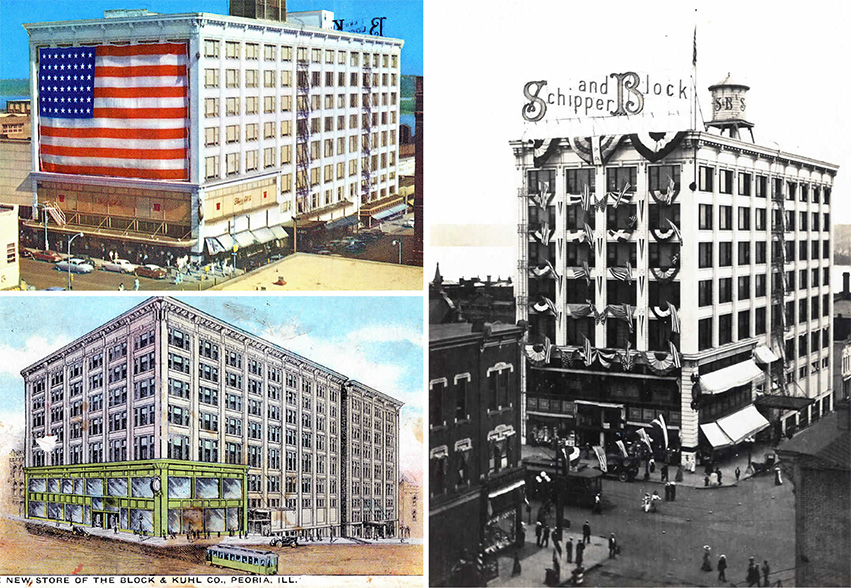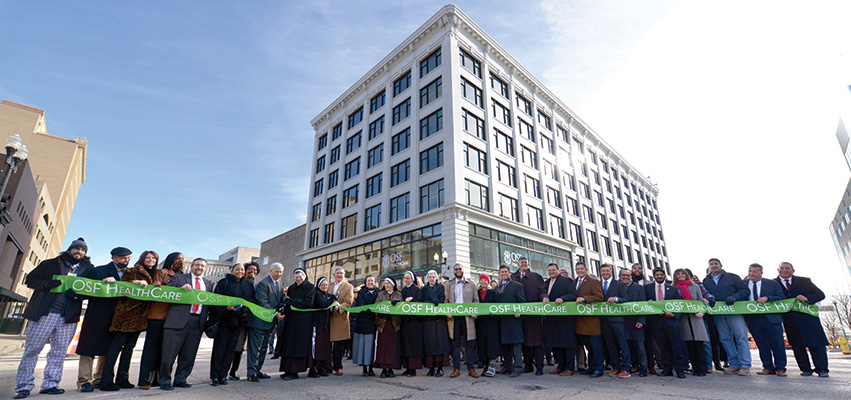
The downtown street, normally open to traffic, was closed and barricaded, portending that something significant was in the works.
One by one, a line of speakers – business, political and religious leaders -- ascended to the podium that frigid morning of Dec. 17, 2021, shivering against the cold but warmed by the satisfaction of what had been accomplished.
Framed by the magnificence of the newly renovated building behind them and a gorgeous mid-morning sun against a clear blue sky, each got up and gave thanks to those they believed were owed their due in making the day a reality – a loving and compassionate God, the corporate decision-makers who took a chance, the government decision-makers who helped put it over the top, the historic preservationists who insisted that no detail be overlooked, the architects and engineers who drew up the plans, the workers who got it done.
The themes to which they gave voice were similar. It was a “glorious day” in the city’s history, the start of “a new chapter” with “a great project” that promises to “spark a renaissance.’’
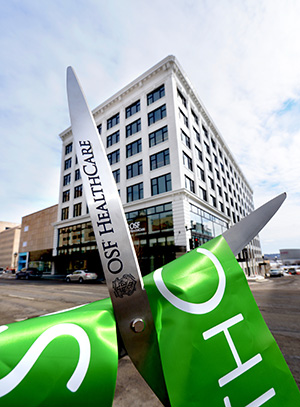 Ultimately, it was Ryan Spain who encapsulated the moment.
Ultimately, it was Ryan Spain who encapsulated the moment.
“It’s a reminder that Peoria, Illinois is a headquarters city,” said Spain, OSF’s vice president of economic development and a state legislator who helped make the project happen on both fronts. “We are a strong city.”
Welcome to 124 SW Adams St., new home of OSF HealthCare’s Ministry Headquarters.
OSF invested $135 million in the building, with the help of $26 million in historic tax credits, $150 million on the entire block bounded by Adams, Main, Washington and Fulton streets.
On any given day, 500 “mission partners” will work full time inside its walls, joined by another 175 employees on hybrid schedules – part remote -- who will rotate in and out, plus visitors.
Between this facility and OSF’s OnCall Center down the block, with 400 employees, that’s more than 1,100 people occupying that stretch of Downtown who weren’t there before. Add the future customers of two restaurants on the property – Great Harvest Bread Company, soon to open, and Travis Moehlenbrink’s Saffron Social – and they can’t help but liven up the neighborhood.
Arguably, the area hasn’t promised this much activity since the building was constructed for the Schipper & Block store – later Block & Kuhl, the “Big White Store,” then Carson Pirie Scott & Co. -- more than a century ago, when Peoria’s Downtown was truly the commercial and retail hub of central Illinois.
Indeed, that day in December was dripping with history and symbolism.
Sister Judith Ann Duvall, Major Superior of the Sisters of the Third Order of St. Francis and chairperson of the boards that oversee the chain of hospitals/health care providers that make up OSF HealthCare, noted that it was just seven blocks down the road, at 708 SW Adams St., nearly a century and a half ago that the Sisters “set up their little house hospital” to care for people “wherever they are.”
“In so many respects, this does feel like coming home,” she said.
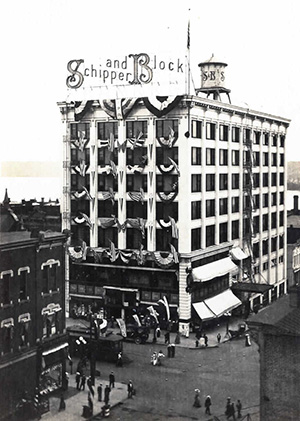
The weight of the moment also went deeper than the obvious connection between past and present, as this new headquarters and how it came to be arguably reveal something foundational about the character and ambition of the city of Peoria itself – its peerlessly deep roots as the oldest permanent European settlement in Illinois, its resilience against the forever changing economic tides, its ongoing, never-say-surrender reinvention.
Indeed, it marries two of the most enduring landmarks in the community -- the 145-year-old institution that is OSF and the 117-year-old building that, at its construction, was the first steel structure in Peoria (and one of the first outside the city of Chicago). At seven stories, it was a skyscraper in its day, as well as an architectural marvel that continues to outshine so much of what has been constructed in central Illinois since.
Meanwhile, it is an example of one prominent headquarters that did so much to shape what central Illinois is today – Caterpillar -- passing the baton to another in OSF as the region’s next economic chapter is being written.
Now that he has the finished product before him, the man who oversaw the renovation, Jim Mormann, OSF’s CEO of Integrated Solutions, can say that four years and $150 million later, it was all worth it. “If I don’t say yes, I’ll never live it down,” he jokes.
But when he first planted eyes on the building in 2017 after Caterpillar indicated it was no longer needed for its own headquarters plans and was willing to effectively give it away – purchase price $1, $3 for the whole block, along with a $3 million donation -- Mormann was still skeptical … and then some.
The downpour outside was only surpassed by the water gushing into the building’s sub-basement from a pipe in the parking garage. The building had been slated for demolition and was “in different states of disarray.” The electricity had been cut off, and the place was cold and dark. Asbestos abatement was already happening. Debris hung from ceilings and some of the walls seemed in danger of collapse. The windows were not solid or safe.
Meanwhile, all the momentum to that point had been for OSF to consolidate its dispersed employees at one brand new headquarters in a green field on Route 91, in the city’s northwest corridor. It wouldn’t have been less expensive, necessarily, but easier, faster, with fewer hoops to jump through.
It would be the Sisters’ decision.
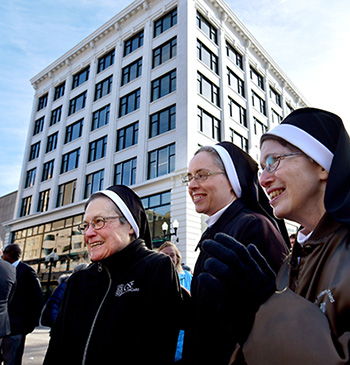 “What is our calling?” Mormann recalls Sister Judith Ann asking. “What is our obligation to the community?”
“What is our calling?” Mormann recalls Sister Judith Ann asking. “What is our obligation to the community?”
There was a general sense that it was important to act not only in the interests of OSF, but of the community. Downtown, the heart of the region, had seen better days and needed a shot in the arm. “If we could help that initiative and help other businesses start seeing the value of reinvesting in the downtown, that fell right along with our calling,” Mormann said.
The decision had been made.
“This is where I believe we should be,” OSF CEO Bob Sehring noted at the ribbon cutting, adding that not only was “an attractive Downtown” important to OSF’s recruitment and retainment of high-quality employees, but also a critical link in an “innovation corridor” containing Bradley University, the Ag Lab, Distillery Labs, Jump Trading Simulation Center, Caterpillar, etc.
As OSF and the community turned the corner into 2018, of course, no one foresaw a global pandemic coming, along with a significant global supply chain disruption, among other surprises.
As cool as the original terra cotta on the building’s façade was, it would have to come down to repair the crumbling brick behind it, then be reinstalled. The heating and cooling system was ancient and in need of replacement. Two whole floors would have to be dismantled and rebuilt from scratch. There were underground tunnels and vaults. Construction workers stumbled upon the old escalators, hidden behind walls. Each of the 350 trademark “Chicago windows,” no two of them alike, had to be custom made. Building codes in 2020 were quite a bit more stringent than in 1904.
And there were other bosses to deal with, specifically the Illinois Historical Society and National Park Service, which had to sign off on everything given the block’s ’s historic landmark status. Sometimes, work would almost come to a standstill.

Still worth it?
“It is a beautiful building,” said Mormann, who complimented the skilled trades that came together to do “really remarkable work” and the researchers – including the Peoria Public Library’s – who helped OSF remain faithful to the structure’s heyday look and spirit.
“It’s such an integral part of who we will be as a ministry ... yeah, you take a lot of pride in it,” he said. “We think it’s a vital, vital piece to the rejuvenation of downtown.”
If the exterior is impressive to those driving or walking by, well, inside, it’s really something to behold.
OSF had to decide on an era to guide the restoration, and landed on the 1940s-‘50s as the peak look and also the most functional in terms of modern-day work flow. A time traveler from that period certainly would recognize the building’s 350 columns and ornate capitals. The building brags spectacular views of the downtown and bridged river. The historic stairwells remain. A thoroughly modern touch is the rooftop garden over the third-floor annex.
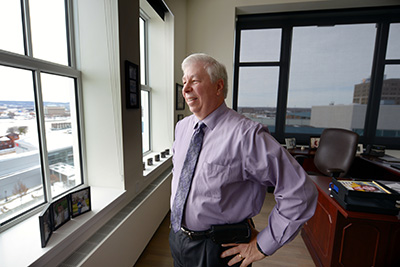
Meanwhile, parts of the block, largely along Main Street, are ripe for development. OSF – which is a health care provider, after all -- is hoping others step up to do that.
Already, the building is getting rave reviews. OSF Spokeswoman Shelli Dankoff alludes to the number of people with fond memories of the place who have approached OSF executives to say “thank you for saving this building.”
Just a few weeks in, “we already see the benefits we would have hoped to see,” said Sehring, noting the “casual collisions” of people and ideas that really move any company and community forward.
They’re thrilled at the nearby Jimmy Johns, where they’re already making more sandwiches and thinking about extending their hours.
“Peoria’s downtown is and will remain the flagship for our region,” said Michael Freilinger, president and CEO of the Downtown Development Corporation. “The relocation of OSF’s Headquarters to downtown Peoria is an example of corporate leadership and investment.
“This is another giant step forward … I am excited about our future.”
Chris Setti, CEO of the Greater Peoria Economic Development Council, also sees the project as a catalyst, especially coming out of COVID. Between the headquarters and OSF’s Cancer Therapy Center -- health care now is the region’s largest employer -- “adding to downtown's daytime population is incredibly important,” he said. “A vibrant downtown Peoria is not just important to the city, it is critical to the entire region … Investments like OSF's are important to build momentum and help showcase the region to potential businesses and individuals.”
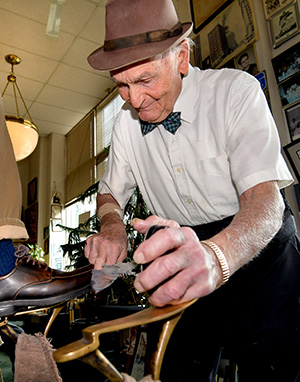
For another local institution, albeit a human one, it’s a potential career extender. At nearly 91, George Manias has been operating his Shoeshine and Hatters business in Downtown Peoria for 75 years, the last 34 of those at his current 101 SW Adams location, in the shadow of the new headquarters.
He’s been around long enough to have put a fine polish on the shoes of every Illinois governor since 1952 – and a few U.S. presidents, as well -- and he well remembers when Downtown’s sidewalks were truly busy and buzzing. It’s been a while, which is why he’s thought about calling it a career.
But now there are signs of life, OSF’s CEO is a customer, and he’s hopeful he might bring along some co-workers the next time.
He’s not making any promises – “It’s up to the guy up there” – but he’d love to celebrate his 100th birthday right here, polish and cloth in hand. With the big white building across the street, the odds have improved.
Ultimately, a building was restored here, but this also is about restoring a community’s pride.
Once upon a time, Peoria was a vaudeville city, a whiskey city, a muscle-flexing river city that manufactured products and exported people that changed the world. It had big-time ambitions.
“This town had a lot of swagger,” said Mormann. “We gotta bring it back.”
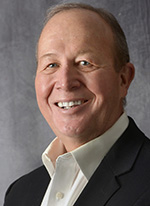
Mike Bailey is editor in
chief of Peoria Magazine.
VITAL STATS
- NAME: OSF HealthCare Mission Headquarters
- ADDRESS: 124 SW Adams St.
- COST: $135 million for renovation of the building itself, including $26 million in historic tax credits, $150 million for entire block
- GENERAL CONTRACTOR: POINTCORE Construction
- ARCHITECT: PSA Dewberry
- BUILDING SIZE: 275,865 square feet over seven levels and sub-basement
- WORKERS: 800 trades people across 56 trade partners, dedicating 350,000 on-site hours to the project
- FEATURES: More than 350 Chicago-style windows, 350 columns and capitals, a new center stairwell weighing 45 tons, 181 miles of electrical conduit (distance from Peoria to Indianapolis), 121 miles of data cable (equal to the distance from Peoria to Chicago), 64,000 sheets of drywall, 3,700 gallons of paint.
BUILDING HISTORY AND TIMELINE
- 1904-05: Originally constructed for Schipper & Block Department Store, first steel building in Peoria
- 1914: Becomes Block & Kuhl Department Store, known to most as “The Big White Store”
- 1961: Carson, Pirie, Scott & Co. moves in
- 1976: Carson, Pirie, Scott & Co. closes
- 1977-2015: Houses Jefferson Bank, then Chase Bank, various offices
- 2015: Caterpillar Inc. purchases building, intends to raze it for new headquarters project
- 2018: With Caterpillar headquarters relocating, OSF HealthCare announces purchase of building for $1 on Jan. 11 and says it will become new health care headquarters. Design plans initiated, abatement and interior demolition begun
- 2019: Exterior façade renovation begins in May
- 2020: Interior build-out begins in January. COVID-19 pandemic hits hard in March, accompanied by supply chain problems that delay material delivery, prolonging construction
- 2021: Formal ribbon cutting on Dec. 17
- 2022: Move-in begins in January
